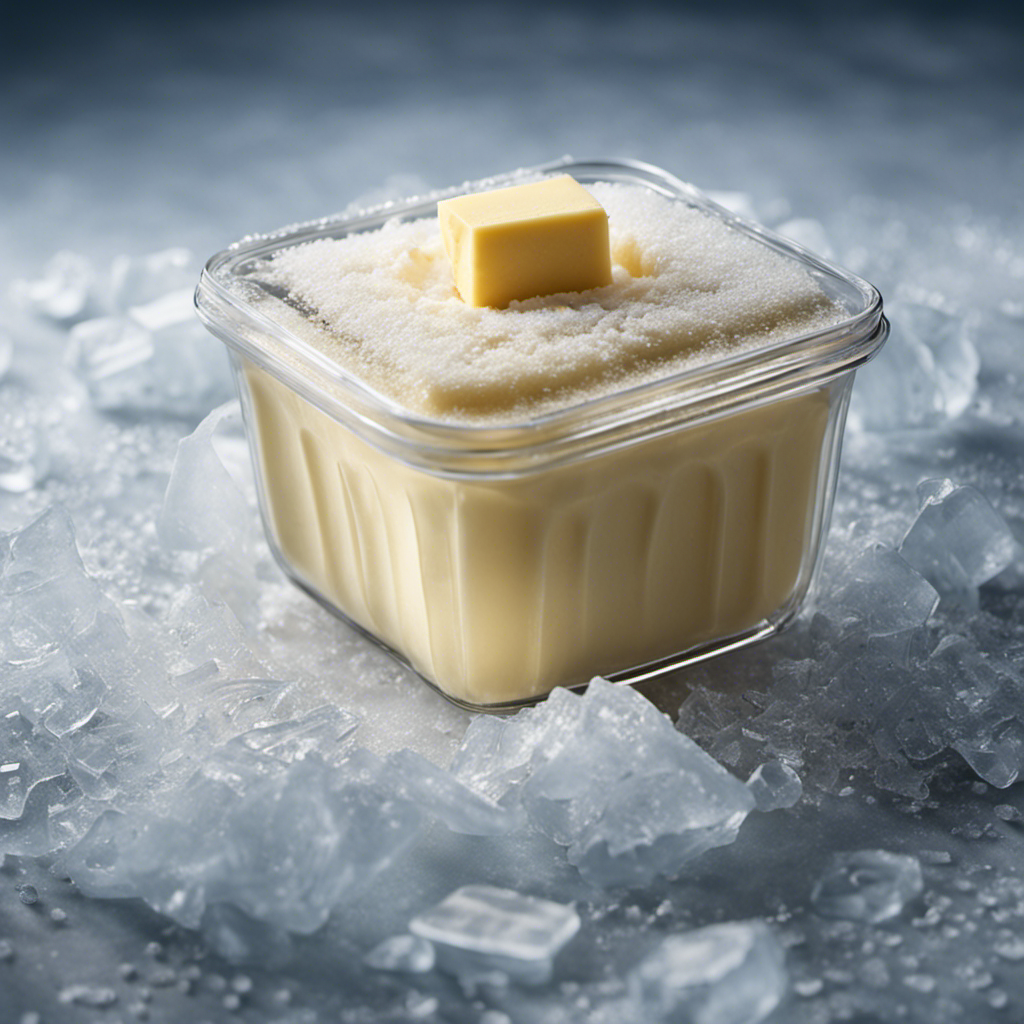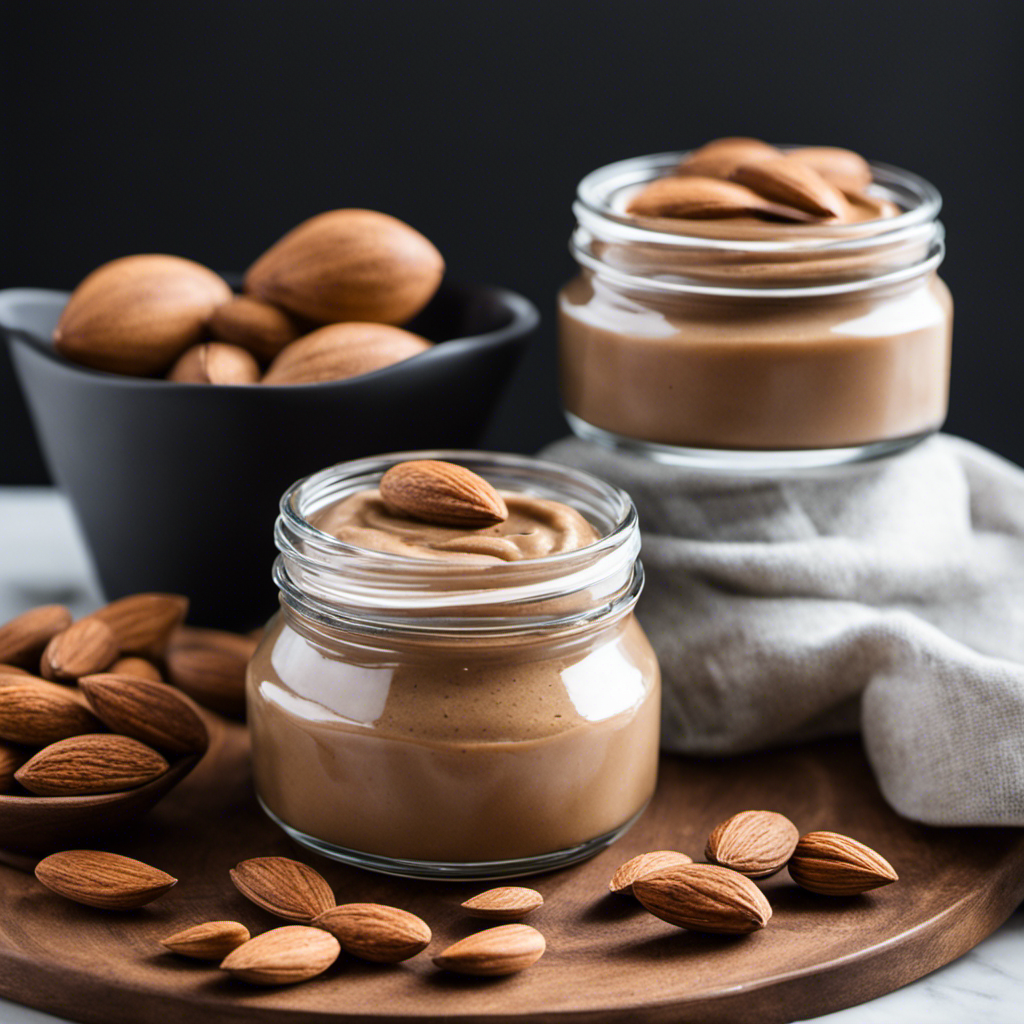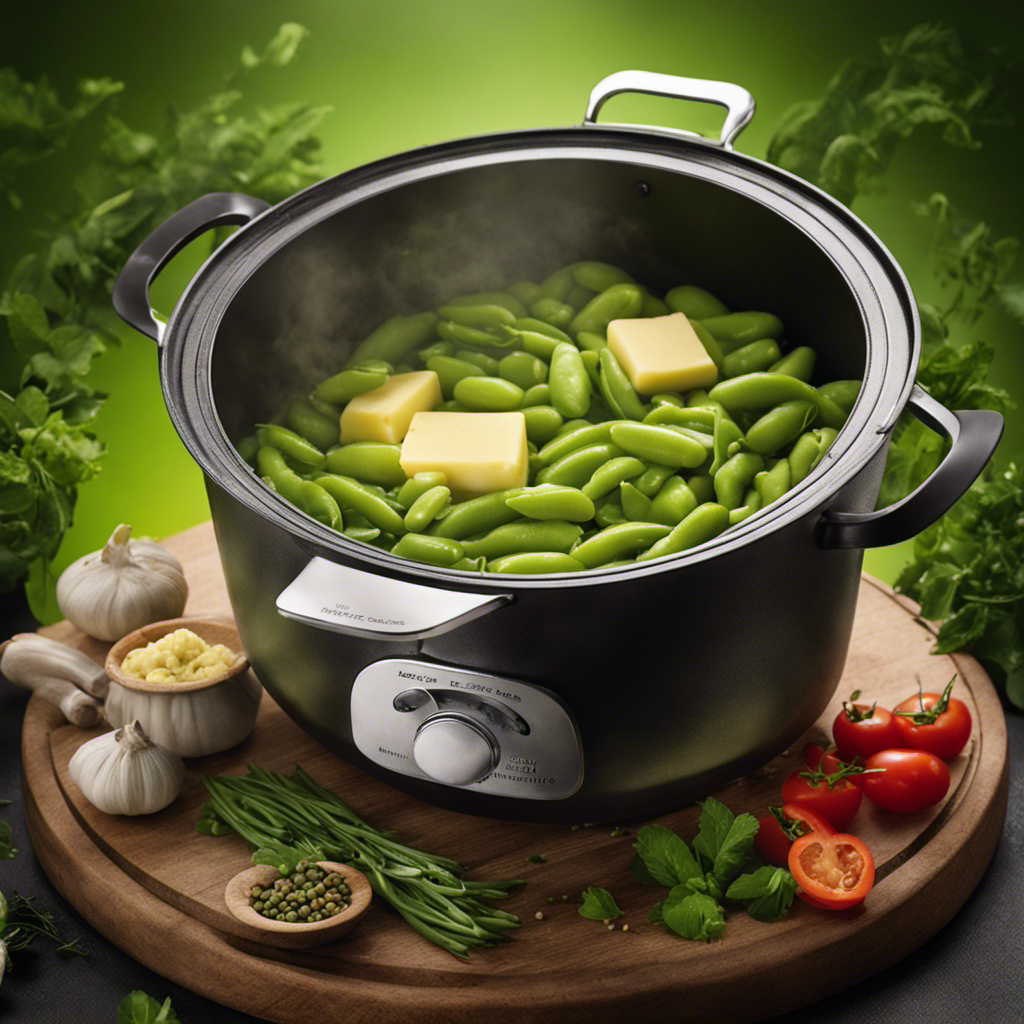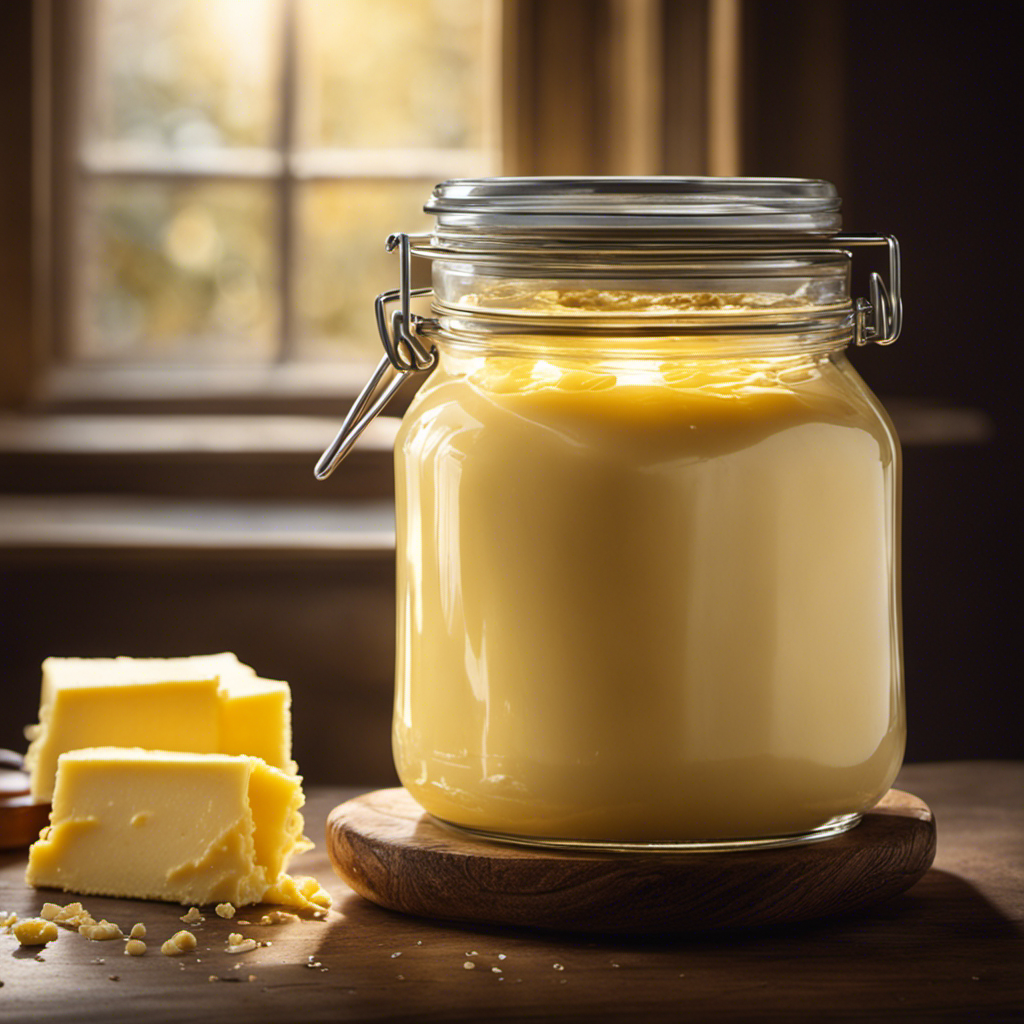Are you aware that frozen butter can typically last for up to one year?
As a butter enthusiast, I’ve always wondered how long this creamy delight can last in the freezer.
In this article, we will explore the science behind freezing butter and the factors that can affect its shelf life.
I will also provide you with recommended storage times, tips for packaging, and creative uses for frozen butter.
So, let’s dive in and discover how long we can keep our butter perfectly preserved in the freezer!
Key Takeaways
- Butter can be stored in the freezer for up to 6 months.
- Proper packaging with airtight containers, plastic wrap, or aluminum foil prevents freezer burn and maintains freshness.
- Freezing butter multiple times can negatively affect its quality.
- Thaw butter in the refrigerator for at least 24 hours for optimal results.
The Science Behind Freezing Butter
If you’re wondering about the science behind freezing butter, you’ll be interested to know that it can be stored in the freezer for up to six months. Freezing butter is a common practice to extend its shelf life and ensure it stays fresh.
When it comes to frozen butter storage methods, it is important to wrap it tightly in plastic wrap or aluminum foil to prevent any air from reaching it. This helps maintain its quality and prevents freezer burn. The freezing process affects the texture of butter, making it harder and less spreadable. However, once thawed, the butter will regain its original texture and taste.
It is important to note that freezing butter multiple times can negatively impact its quality. Now, let’s explore the factors affecting butter shelf life in the freezer.
Factors Affecting Butter Shelf Life in the Freezer
Factors like temperature and packaging can affect how long butter will stay fresh in the freezer. When it comes to freezing butter, there are several factors that play a role in maintaining its quality and prolonging its shelf life. Here are some key factors to consider:
-
Temperature: It is crucial to maintain a constant freezing temperature of 0°F (-18°C) or lower to prevent the growth of bacteria and maintain the butter’s texture and flavor.
-
Packaging: Proper packaging is essential to prevent freezer burn and maintain the butter’s freshness. Use airtight containers or wrap the butter tightly in plastic wrap or aluminum foil to protect it from moisture and odors.
-
Quality of butter: The quality of butter before freezing also affects its longevity in the freezer. Using fresh, high-quality butter will result in better taste and texture after freezing.
Recommended Storage Time for Frozen Butter
When storing butter in the freezer, it’s important to remember that the recommended storage time is typically around 6 to 9 months. This ensures that the butter maintains its quality and taste for an extended period. To illustrate the recommended storage methods and best practices, refer to the table below:
| Storage Method | Recommended Time |
|---|---|
| Sealed container | 6 to 9 months |
| Wrapped in foil or freezer paper | 6 to 9 months |
| Vacuum-sealed | Up to 12 months |
By following these storage methods, you can ensure that your frozen butter stays fresh and free from freezer burn. It’s essential to label the containers with the date of storage to keep track of the butter’s age. Additionally, make sure to place the butter in the coldest part of the freezer to maintain its quality.
In the next section, we will discuss the signs of spoiled butter in the freezer and how to identify them.
Signs of Spoiled Butter in the Freezer
When it comes to frozen butter, it’s important to know the signs of expiration and how to identify spoiled butter in the freezer.
One telltale sign of expired butter is a rancid smell, so be sure to trust your nose.
Additionally, if the butter has developed an off-color or strange texture, it’s likely no longer safe to consume.
Frozen Butter Expiration Signs
To determine if your frozen butter is still good to use, check for any signs of expiration. When butter starts to go bad, it develops a rancid smell and taste. Look for discoloration or mold on the surface of the butter as well. If you notice any of these signs, it’s best to discard the butter.
However, when stored properly, frozen butter can last for up to 6 months without losing its quality. Here are some tips for storing butter in the freezer:
- Wrap butter tightly in plastic wrap or foil to prevent it from absorbing any odors.
- Place the wrapped butter in an airtight container or freezer bag to protect it from freezer burn.
- Label the container with the date of freezing to keep track of its storage time.
Benefits of freezing butter include extending its shelf life and allowing you to stock up when there are sales or promotions. Freezing butter is a convenient way to always have it on hand for baking or spreading on toast.
Identifying Spoiled Freezer Butter
In my experience, identifying spoiled butter can be a bit tricky. However, there are a few telltale signs to look out for.
First, check the texture. Spoiled butter tends to become greasy and slimy, losing its original creamy consistency. It may also develop an off-putting odor, similar to rancid oil or sour milk.
Secondly, look for any discoloration. If you notice any dark spots or a yellowish tint, it’s a sign that the butter has gone bad.
Lastly, trust your taste buds. If the butter tastes sour or has a strange, unpleasant flavor, it’s best to discard it.
To avoid spoilage, proper storage techniques are essential. Keep your butter in an airtight container or wrap it tightly in foil or wax paper to prevent exposure to air and moisture. Store it in the refrigerator, away from strong-smelling foods.
Following these guidelines will help keep your butter fresh and delicious for longer.
Tips for Properly Packaging Butter for Freezing
Make sure you’re properly packaging your butter when freezing it to maintain its quality. Here are some tips to help you with the process:
-
Labeling frozen butter:
-
Use a permanent marker to write the date of freezing on the packaging.
-
Include the type of butter (salted or unsalted) to easily identify it later.
-
Note any special additions, like herbs or spices, for future reference.
-
Best containers for freezing butter:
-
Opt for airtight containers or freezer bags to prevent freezer burn.
-
Use small containers or individually wrapped portions for convenience.
-
Glass containers with tight-fitting lids are also a good option.
Properly labeling your frozen butter ensures that you can easily identify and use it when needed. Choosing the right containers helps maintain its quality and prevent freezer burn. By following these tips, you can keep your frozen butter fresh for an extended period.
Thawing Frozen Butter Safely
When it comes to thawing frozen butter, there are several factors to consider in order to ensure optimal results.
First and foremost, it’s important to use the right thawing method to preserve the quality and texture of the butter.
Additionally, taking necessary precautions to prevent spoilage and considering the shelf life of the butter are crucial steps in maintaining its freshness and taste.
Optimal Thawing Methods
Thawing butter in the refrigerator is the best method to maintain its texture and flavor. When it comes to thawing butter, there are a few key points to keep in mind to ensure optimal results:
-
Thawing Time: It is recommended to thaw butter in the refrigerator for at least 24 hours. This slow thawing process allows the butter to gradually reach its original consistency, minimizing any potential texture changes.
-
Storage Containers: To prevent any cross-contamination or moisture loss during the thawing process, it is essential to use the best storage containers. Airtight containers or resealable bags are ideal for preserving the quality of the butter while it thaws.
-
Temperature Control: Keeping the refrigerator temperature at a consistent 40°F (4°C) or below is crucial for maintaining the quality and safety of the butter during the thawing process.
By following these guidelines, you can ensure that your butter thaws properly, preserving its texture and flavor for all your culinary creations.
Butter Spoilage Prevention
To prevent butter from spoiling, it’s important to store it in airtight containers or resealable bags. Proper butter storage techniques can help preserve its quality and extend its shelf life.
When exposed to air, butter can absorb odors and flavors from its surroundings, leading to a decrease in its overall quality. By storing butter in airtight containers or resealable bags, you can protect it from these external factors.
Additionally, keeping butter in the refrigerator helps to maintain its freshness and prevent it from becoming rancid. It’s also essential to check the expiration date on the packaging before purchasing butter and to consume it before the indicated date for optimal quality.
By following these storage techniques, you can ensure that your butter stays fresh and flavorful.
Now let’s delve into shelf life considerations.
Shelf Life Considerations
When it comes to freezing butter, there are several factors that can affect its quality and shelf life. It’s important to understand these factors in order to ensure the best results when freezing butter.
Here are some best practices to keep in mind:
-
Temperature: Butter should be stored at temperatures below 0°F (-18°C) to maintain its quality and prevent spoilage.
-
Packaging: Ensure that the butter is tightly sealed to prevent freezer burn and absorption of odors from other foods in the freezer.
-
Duration: While butter can be safely frozen for up to 12 months, it is best to use it within 6-9 months for optimal quality.
-
Exposure to air: The longer butter is exposed to air, the greater the risk of quality deterioration. It is recommended to divide the butter into smaller portions before freezing to reduce air exposure.
-
Butter quality: The quality of the butter before freezing will also impact its quality after thawing. It is best to freeze fresh, high-quality butter for the best results.
Creative Uses for Frozen Butter
Did you know that frozen butter can be used to make flaky and delicious pie crusts? It’s true! Besides being a staple in the kitchen, butter has a variety of uses when frozen.
One popular use is for baking, as frozen butter can help create that perfect flaky texture in pie crusts, biscuits, and scones. Additionally, frozen butter can be grated and used as a topping for vegetables, pasta, or popcorn, adding a rich and creamy flavor.
As for butter preservation techniques, freezing is a great option to extend its shelf life. By wrapping butter tightly in plastic wrap or placing it in an airtight container, you can keep it in the freezer for up to 6-9 months. This allows you to always have butter on hand for your culinary creations.
But how can you tell if frozen butter has gone bad? Let’s find out in the next section.
How to Tell If Frozen Butter Has Gone Bad
If your frozen butter develops a rancid smell or taste, it’s time to throw it out. Identifying rancid butter is important to prevent any unpleasant experiences. Here are some common storage mistakes that can lead to butter going bad:
- Exposure to air: Oxygen can cause butter to oxidize and develop off-flavors.
- Improper packaging: Using containers that are not airtight can allow moisture and odors to seep into the butter.
- Incorrect temperature: Keeping butter at a temperature above freezing can lead to spoilage.
To determine if your frozen butter has gone bad, trust your senses. Look for discoloration or mold on the surface. Smell for any off-putting or sour odors. Finally, taste a small amount to check for a rancid or unpleasant flavor. If any of these signs are present, it’s best to discard the butter.
Now that you know how to identify rancid butter and avoid common storage mistakes, let’s move on to some frequently asked questions about freezing butter.
Faqs About Freezing Butter
Remember to always store your frozen butter in airtight containers to prevent moisture and odors from affecting its quality.
When it comes to thawing techniques, there are a few options to consider. The safest method is to transfer the frozen butter from the freezer to the refrigerator and allow it to thaw slowly overnight. This gradual thawing process helps maintain the butter’s texture and flavor.
However, if you need to speed up the thawing process, you can place the wrapped butter in a sealed plastic bag and submerge it in cold water. Change the water every 30 minutes to ensure it stays cold.
As for alternative storage methods, you can freeze butter in smaller portions using ice cube trays or silicone molds. This allows for convenient portioning and easy access when needed.
Frequently Asked Questions
Can I Freeze Salted Butter?
Yes, you can freeze salted butter. When freezing unsalted butter, wrap it tightly in plastic wrap or place it in an airtight container. To thaw frozen butter, transfer it to the refrigerator overnight.
Can I Freeze Butter in Its Original Packaging?
Yes, you can freeze butter in its original packaging. However, freezing butter can affect its texture. It may become crumbly or grainy. It’s best to wrap it tightly in plastic wrap or place it in a freezer-safe container to maintain its quality.
How Long Can I Keep Frozen Butter in the Freezer?
Butter can be kept frozen for up to six months. It should be stored in an airtight container to prevent freezer burn. If you find yourself with too much frozen butter, consider using it in baking or cooking for added flavor.
Can I Refreeze Butter After It Has Been Thawed?
Yes, you can refreeze butter after it has been thawed. The best way to thaw butter is to place it in the refrigerator overnight. This ensures gradual thawing and maintains the butter’s quality.
Can I Freeze Butter That Has Already Been Opened?
Yes, you can freeze unsalted butter. It is best to transfer it to a freezer-safe container if it’s not already in one. Glass containers are suitable for freezing butter as long as they have enough space for expansion.
Conclusion
In conclusion, freezing butter is a great way to extend its shelf life. By understanding the science behind freezing and the factors that affect butter’s quality in the freezer, we can ensure that our butter stays fresh for longer.
Proper packaging and thawing techniques are crucial to maintain its taste and texture. Remember, like a hidden treasure waiting to be discovered, frozen butter can be a versatile ingredient in various recipes.
So, don’t hesitate to embrace the cold and freeze your butter to enjoy its goodness for an extended period.










